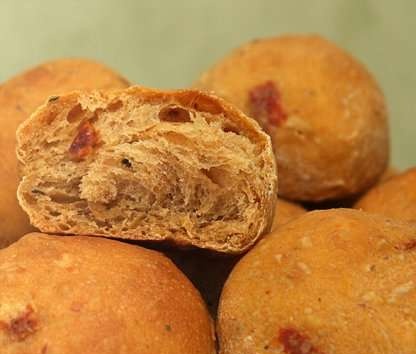contramot5,
If you
are right about the dispenser, then you need to carry the stove to the service center... Since the time is programmatically regulated, you are unlikely to do anything at home, besides, the stove is still under warranty.
You need to make sure visually and by analyzing the entire mode, and not just by clicks. Because
the time 3.43 should be on the "winter" version of the stove operation, when standing for only 1 hour, if the stove switched to a reduced summer mode with standing up to 1 hour 40 minutes, then the dispenser opening on program 6 will be later according to the instructions up to about 40 minutes, then there may be at 3.07, depending on the temperature in the room and the time of the "summer batch". You need to observe when the kneading starts in program 6 and when
opens!, and not only clicks, the dispenser. If it opens in 5-6 minutes
until the end of the batch already at almost
totally mixed dough - then everything is fine.
Otherwise, bring it to the service.
If no defect is found, then
on the 10th loaf, the stove starts to "glitch", possibly due to the fact that the temperature rises in the room and it switches to the "summer" mode, or if you mercilessly exploited it for a long time and did not pull it out of the socket, and there the voltage jumps (if you do not bake, let the stove rest, be sure to unplug it - reset and cool the electronics).
Even when not there is enough voltage, the stove starts to fail, heats up weaker. At the time of the glitch, you can run test mode and make sure of suspicions, then measure the voltage to eliminate network problems. If your network is so bad, then only the stabilizer will save the situation.
If the technique is okay, then look for the cause in the technology.
No additive dispenser can stop the yeast from raising the dough. The additive dispenser can only add or cause draft during baking unevenly additives will intervene. But he cannot influence either kneading or raising the dough. And a draft when baking from a maximum of one side of the loaf will give a small defect in the form of an explosion, or the color of the crust can be affected in the worst case.
Your yeast doesn't work as described. There is no lift.
The roof bursts violently if dry dough or explosive growth of the workpiece in the oven, that is, underdevelopment, or both.
You knead in a smart bread maker, it can only under-weigh if the consistency of the dough is severely disturbed: either a tight lump rolls around the bucket, or a complete slurry, in all other cases it will cope with minor flaws, but in these two extreme cases the yeast will also not cope and may not raise the dough. In Easter cakes, liquid is often allowed, but there is a lot of thinness. Yeast will not raise excessive slurry or the oven will not bake.
If you think primitively, then the bread does not rise due to the poor performance of the yeast. If the yeast worked well, then even if it does bad flour, all the same good yeast will raise bread. It will turn out disgusting bread tastes good, but should rise if the yeast has worked.
If the yeast did not work, then either few, or they are in bad for them conditions.
The dog can be buried in a very hot time in "summer"operating mode of the stove above 26 degrees. And the dispenser will also work in summer mode later. reduces fermentation time and normal yeast rate can do not have time raise the dough, especially if they were activated in cold conditions, or vice versa, they are too raise hot dough - this case is not similar to yours in the description, because even with over-spreading, the bread is still high enough, only sluggish and large defects at the roof.
You gotta try observe the stove at every stage and find the error and adjust to your technique.
It is possible to adjust the amount of yeast and even the temperature of the water in warm weather. The instructions say "take water from the tap", but in summer and winter this water is not the same in temperature
The chances of mistakes only in your actions are high enough. Kulich highly tasty, with an increased amount of oil and sugar, product, yeast spoilage is not a problem. Kneading too steep or very wet dough is also easy enough. In general, check your actions a hundred times, especially for the careful attitude to yeast and their choice. Dry yeast is very easy to kill or weaken even with a cool dough. Direct contact with baking should not be allowed.
Cake theory is well described in separate sections.
The only thing that could still be checked: Altai flour, which with 12-13 percent protein can be very moisture-absorbing and strong and require increased mixing and increased amount of moisture. On program 6, kneading is gentle, it is intended for whole grain flour, which does not differ in increased strength. That is, there may still be a weak kneading of super-strong flour, and if there was also little moisture, then the yeast did not raise the under-mixed dough, perhaps even too much dry(maybe yes, maybe not. But the roof has burst, the lack of moisture cannot be ruled out, and yeast will not cope with the tight unmixed dough).
Track all the stages of mixing. I see no reason to change the flour if the cake tasted good. It is necessary to correct moisture, yeast (live yeast for cake is better, dry yeast is easier to kill) and you may have to switch to the main program.
In the main program, the fermentation is initially intended to be shorter, that is, the kneading is more intense and fermentation at higher temperatures. It is possible that more hot kneading and fermentation activates your yeast better, just as improved kneading makes it easier for it to work in the dough.
In short, at first glance, everything again depends on your picky yeast. Surely, according to the description, you can make a mistake, but it looks like they require an exceptionally warm batch, or maybe you should have put more of them in the cake. It was necessary to look at the rise of the dough in the process of fermentation.
The French and Diet regimens are distinguished by a more delicate approach and lower fermentation temperatures. And the most delicate in French. There it is necessary, on the one hand, to reduce the amount of yeast, but on the other hand to ensure their uninterrupted operation at lower temperatures.
The main mode is the most hassle-free and simple.
Hope you are lucky and the reason is not in the stove.
Added Sunday, May 29, 2016 02:25 AM
Hello, I would like to ask what is the best way to leave the bread maker after the end of baking - with the lid open or closed? And does this even affect the mechanism of the bread maker?
with the lid open, the bread maker is rather cooled and ventilated. If you are determined to bake several times after a short time, then it is better to refrigerate with the lid open and with the plug removed from the mains. If you still do not intend to bake soon, then
Skyso, It is absolutely all the same as it is more convenient for you.
just de-energize. This will help to avoid glitches, and the voltage in the network can jump.





